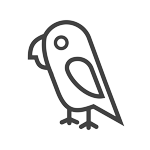
Pomeranian Breed: Traits, Care & Temperament
Pomeranians have captured the hearts of many Australians, becoming a favoured choice for urban dwellers seeking a compact yet spirited companion. Their diminutive size, coupled with a vivacious personality, makes them particularly suited to city living, where space might be limited but the desire for a lively pet remains boundless.
In this comprehensive guide, we'll delve into the world of Pomeranians, exploring their distinctive traits, care requirements, and temperament. Whether you're contemplating bringing a Pomeranian into your home or simply curious about this enchanting breed, read on to discover what makes these fluffy canines so special.
What Does a Pomeranian Look Like?
Pomeranians are classified as a toy breed, typically weighing between 1.36 to 3.17 kilograms (3 to 7 pounds) and standing about 20 to 28 centimetres (8 to 11 inches) tall at the shoulder. Despite their small stature, they possess a sturdy and compact frame.
One of the breed's most striking features is its luxurious double coat, which forms a prominent ruff around the neck and a feathery plume on the tail that arches over the back. Pomeranians come in a dazzling array of colours, including orange, black, chocolate, cream, blue, sable, and combinations thereof. This diversity allows prospective owners to choose a Pomeranian that truly matches their aesthetic preferences.
Pomeranian Personality: Are They Really That Feisty?
Don't let their petite size fool you; Pomeranians are brimming with confidence and charisma. They are often described as lively, bold, and inquisitive, always eager to explore their surroundings and engage with their human companions.
Their alert nature makes them excellent watchdogs, as they won't hesitate to announce the arrival of visitors or any unusual activity. However, this vigilance can sometimes translate into excessive barking, a trait that potential owners should be prepared to manage through training and socialisation.
Pomeranians are known to form strong bonds with their families and can be quite affectionate. They often believe they're much larger than they are, displaying a fearless attitude that can be both amusing and endearing. This "big dog in a small body" mentality means they require guidance to ensure their boldness doesn't lead them into trouble.
Anecdotal evidence from Pomeranian owners often highlights their dog's spirited antics. One owner shared how their Pom would confidently challenge much larger dogs at the park, oblivious to the size difference, embodying the breed's fearless and lively temperament.
Living With a Pomeranian in Australia
Is Apartment Living Suitable for Pomeranians?
Absolutely. Pomeranians adapt well to apartment living due to their small size. However, their energetic nature means they still require regular exercise and mental stimulation to prevent boredom. Interactive toys and daily play sessions can help keep them engaged.
How Do Pomeranians Handle the Australian Climate?
Australia's climate varies, but in warmer regions, Pomeranians can be sensitive to heat due to their thick double coats. It's essential to provide plenty of water, shade, and avoid outdoor activities during the hottest parts of the day. Some owners opt for a summer trim to help their Poms stay cool, but be cautious not to cut the coat too short, as it also provides insulation against heat.
Are Pomeranians Too Vocal for Close Neighbours?
Pomeranians are known for their vocal tendencies. While this makes them excellent watchdogs, it can be a concern in close living quarters like apartments. Early training to manage excessive barking and providing sufficient mental stimulation can help mitigate this behaviour.
Pomeranian Grooming Guide: Fluff Comes With Responsibility
Maintaining a Pomeranian's luxurious coat requires regular grooming. Daily brushing is recommended to prevent matting and tangling, especially around the neck and behind the ears. A slicker brush and a metal comb are essential tools for this task.
Bathing your Pomeranian every three to four weeks helps keep their coat clean and reduces odours. Always use a dog-specific shampoo to maintain skin health. Regularly checking and cleaning their ears, trimming their nails, and brushing their teeth are also crucial components of their grooming routine.
Do Pomeranians Shed?
Yes, Pomeranians do shed. They experience seasonal shedding, often referred to as "blowing coat," typically during spring and autumn. During these periods, increased brushing can help manage the excess hair and keep your home fur-free.
Pomeranian Exercise Needs: How Much Is Enough?
Despite their small size, Pomeranians are active and enjoy regular exercise. Daily walks of about 20 to 30 minutes, coupled with playtime, are usually sufficient to keep them happy and healthy. They also excel in agility and obedience activities, which provide both physical exercise and mental stimulation.
Interactive games like fetch or hide-and-seek with toys can keep their minds sharp. Remember, a tired Pomeranian is a well-behaved Pomeranian.
Pomeranian Health & Lifespan:

Pomeranians are generally healthy but are prone to certain conditions:
-
Luxating Patella: A condition where the kneecap slips out of place.
-
Dental Issues: Due to their small mouths, they can experience overcrowded teeth leading to dental disease.
-
Tracheal Collapse: A weakening of the tracheal rings causing breathing difficulties.
Regular veterinary check-ups are vital to catch and manage these issues early. Pomeranians typically enjoy a lifespan of 12 to 16 years, though some have been known to live even longer with attentive care and a healthy lifestyle. It’s not unusual to hear of a well-loved Pom reaching 17 or 18, especially when their humans stay on top of their dental hygiene and nutrition. As with many toy breeds, a longer lifespan is quite common—but only if their specific needs are met consistently.
How Often Should Pomeranians Visit the Vet?
While young and healthy Pomeranians can usually get by with an annual check-up, senior dogs or those with ongoing health concerns may need to be seen twice a year. Puppies should follow a structured schedule for vaccinations, deworming, and general development checks in the first year of life.
Don't skip dental check-ups, either. Toy breeds like the Pom are particularly susceptible to tartar build-up and gum disease. If you’ve ever had a dog with tooth troubles, you’ll know it’s no small matter—pain, infections, and even organ issues can stem from poor dental health. Investing in regular cleanings and even canine dental chews can make a world of difference.
Feeding a Pomeranian: Nutrition Tips for Tiny Tummies
Feeding a Pomeranian might seem simple at first—they’re small, after all—but their fast metabolism and tiny stomachs mean they need high-quality food that’s nutritionally dense in small portions.
How Much Should You Feed a Pomeranian?
On average, an adult Pom will require anywhere from ¼ to ½ cup of high-quality dry food per day, split into two meals. Puppies may need more frequent, smaller meals—typically three to four times daily until they’re around 6 months old.
What Should You Feed Your Pom?
Look for dog foods specifically formulated for small breeds. They contain more calories per cup and are usually made in smaller kibble sizes to suit tiny jaws. Many Aussie Pom owners opt for premium local brands like:
-
Meals for Mutts
-
Black Hawk
-
Ivory Coat
-
Royal Canin Mini
Avoid overfeeding, as obesity can exacerbate joint issues and put strain on the trachea. Watch the treats too—those puppy-dog eyes are hard to resist, but moderation is key.
Training a Pomeranian: Yes, They’re Stubborn
If there’s one thing Pomeranians are known for—aside from their fluff—it’s their independent streak. They're intelligent, yes, but that doesn't always translate into obedience. A Pom might learn a trick quickly, only to choose not to perform it unless there's something tasty in it for them.
Are Pomeranians Easy to Train?
They can be. The trick is consistency and making training fun. Use positive reinforcement methods—treats, praise, toys—and keep sessions short and engaging. Pomeranians thrive on attention and approval, so lean into that.
Housebreaking Your Pom
Potty training a small dog can be a bit of a challenge. Tiny bladders mean more frequent toilet breaks, especially during the puppy phase. Puppy pads can help in flats or during training, but ideally, get them used to going outside early on.
Crate training, when done correctly, can also support housebreaking efforts, giving your Pom a safe space and reducing indoor accidents.
Socialisation: Start Early
Pomeranians need early exposure to different people, pets, sounds, and experiences. Without proper socialisation, they may become anxious, snappy, or overly reactive. Puppy preschool classes in Australia (often run by local vets or pet stores like Petbarn) are a fantastic place to start.
Is a Pomeranian Right for You?

Still wondering whether this pint-sized powerhouse fits your lifestyle? Let’s recap.
Key Traits to Consider
-
Grooming: Daily brushing and regular grooming are non-negotiable
-
Noise Level: Not ideal if your neighbours are sensitive to barking
-
Sociability: Loves human company but needs early socialisation
-
Size: Perfect for apartment living but still needs daily play
Who Are Pomeranians Best Suited For?
-
Singles and retirees who can offer companionship and attention
-
Families with older children (tiny dogs can be fragile)
-
Dog-experienced households who understand their bold personality
How Much Does a Pomeranian Cost in Australia?
Prices vary. Purebred Pomeranian puppies from registered breeders can range from $2,000 to $5,000 AUD, depending on lineage, location, and colour. Pomeranian cross Chihuahuas or other mixes may be more affordable but can still cost $1,500 or more. Adoption is usually cheaper—often just a few hundred dollars to cover vet checks and desexing.
A Day in the Life of a Pom Owner
You wake up to a happy little furball bouncing at the foot of your bed. Breakfast is served with a side of excited spins. After a brisk morning walk, your Pom spends the day either curled beside your desk or perched by the window, keeping a close eye on the world (and barking at suspicious-looking pigeons). Come evening, it’s playtime again, followed by cuddles on the sofa. By bedtime, your Pom’s nestled back under the doona like a furry hot water bottle.
Pomeranians might be small, but don’t be fooled—they’ve got big dog energy, a strong sense of loyalty, and enough personality to fill a stadium. They demand your attention, your care, and occasionally your sanity when they’re barking at the wind, but oh, do they give back tenfold.
If you’re thinking of bringing one home, whether you’re a city dweller in Sydney or living coast-side in Cairns, make sure you’re prepared for the commitment. Research breeders with care or consider adoption—there are always rescue Poms and Pom mixes (like the Pomeranian cross Chihuahua, affectionately called a Pomchi) looking for loving homes.
Just remember: beneath all that fluff is a bold little heart that wants nothing more than to be your shadow.
Poms can easily overheat, so in hot Aussie summers, look for breathable raised dog beds or cooling memory foam options. Brands like PaWz offer lightweight, easy-to-clean beds ideal for small breeds.










Leave a comment